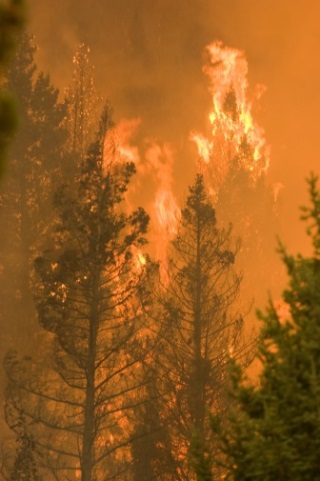 Kari Greer/ NIFC (creative commons license); Castle Rock Fire, Ketchum, ID 2007; National Interagency Fire Center Photo Gallery
Kari Greer/ NIFC (creative commons license); Castle Rock Fire, Ketchum, ID 2007; National Interagency Fire Center Photo Gallery
Between 2010 and 2014, an average of 1,192 wildland fires, excluding prescribed fires, occurred annually in Colorado. The number of acres can vary greatly; for example, in 2014, a reported 24,949 acres burned throughout the state, while in 2012 a total of 246,445 acres burned due to wildland fires. Annual structural losses across the state also fluctuate. Between 2012 and 2013, more than 1,200 structures were damaged or destroyed by wildfires that swept across the state, resulting in nearly $1 billion in property damage. Other years, however, have reported significantly fewer structural losses and damage.
Wildfire size (reported as acres burned) is not always indicative of its impact. The Royal Gorge Fire that began on June 11, 2013 outside of Cañon City, burned a total area of 3,218 acres and destroyed 90 percent of the Royal Gorge Bridge and Park. The Royal Gorge Bridge itself was relatively unaffected, but 48 of 52 buildings—including the visitor center, Aerial Tram, Incline Railway, and other attractions—were destroyed. Examples like this illustrate the long-lasting impacts that wildfires can have on the local economy and the variety of community values at risk.
CoreLogic, a national provider of financial and property information, estimates that Colorado ranks as one of the leading states across the western United States in terms of residential properties potentially at risk of future wildfire damage. A 2015 report shows that Colorado has nearly 100,000 homes that are either at high or very high risk of wildfire – translating into $28 billion of residential assets exposed to potential future wildfire damage.These trends also reflect a larger pattern associated with increased development in wildfire-prone areas in the West. Community wildfire risk will continue unless more action is taken to reduce and/or mitigate the threat.
A 2015 report shows that Colorado has nearly 100,000 homes that are either at high or very high risk of wildfire – translating into $28 billion of residential assets exposed to potential future wildfire damage.
Applicable Planning Tools and Strategies
In addition to the tools and strategies cited below that are included in this guide, landscaping requirements are also important tools for reducing potential risks from wildfire. Landscaping standards often address issues such as plant material selection (e.g., requiring low-water, native vegetation) and the location of new plant materials installed as part of new development.
Addressing Hazards in Plans and Policies
- Comprehensive Plan
- Climate Plan
- Community Wildfire Protection Plan (CWPP)
- Exploratory Scenario Planning
- Hazard Mitigation Plan
- Parks and Open Space Plan
- Pre-disaster Planning
- Resilience Planning
Strengthening Incentives
Protecting Sensitive Areas
Improving Site Development Standards
Improving Buildings and Infrastructure
Enhancing Administration and Procedures
